| Skip Navigation Links | |
| Exit Print View | |

|
Oracle Java CAPS Scheduler Binding Component User's Guide Java CAPS Documentation |
| Skip Navigation Links | |
| Exit Print View | |

|
Oracle Java CAPS Scheduler Binding Component User's Guide Java CAPS Documentation |
Using the Scheduler Binding Component
About the Scheduler Binding Component
Scheduler Binding Component Features
Using the Scheduler Binding Component in a Project
Steps to Create the BPEL Project
Create a Scheduler Binding Component
Create a File Binding Component
Using the Scheduler Control and Triggers Wizard
Accessing the Scheduler Control and Triggers Wizard
Understanding the Scheduler Wizard
Using the Add New Simple Trigger Editor
Using the Add New Cron Trigger Editor
Using the Add New Hybrid Trigger Editor
Example Hybrid Trigger Configuration
Adding Triggers and Editing an Existing Scheduler Project
Accessing the Configure Scheduler Binding Wizard
Scheduler Binding Component Properties
Runtime Properties for the Scheduler Binding Component
Scheduler Binding Component Loggers
Using the Trigger Properties Editor
Trigger Configuration Properties
Scheduler BC Normalized Message Properties
Scheduler Application Configuration
Using Scheduler Binding Component Application Configuration
Defining the Scheduler Application Configuration for a Project
Other Tools Used to Edit the Application Configuration
Scheduler Binding Component Application Variables
Using Application Variables in a Trigger Message
Creating and Using Application Variables
Using Admin Console and asadmin to Create Application Variables
Configuring Redelivery and Throttling for the Scheduler Binding Component
Configuring Redelivery for an Endpoint
Configuring Throttling for an Endpoint
This section provides instructions for you to create a sample Scheduler Binding Component project that contains all three different trigger types, Simple, Cron, and Hybrid. In this sample you create a schedule file to trigger a BPEL provider endpoint with a message and begin a business process instance that performs a task.
The following procedures are used to create the sample Scheduler Project:
The New Project Wizard appears.
The SayHello Project is added to the Projects tree.
The WSDL Document Wizard appears.
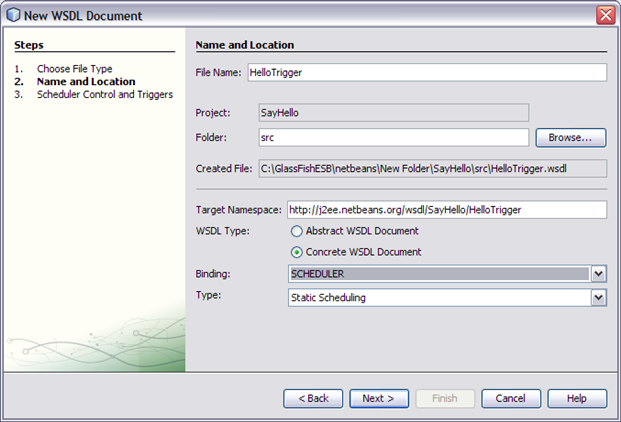
The Scheduler Control and Triggers Wizard appears.
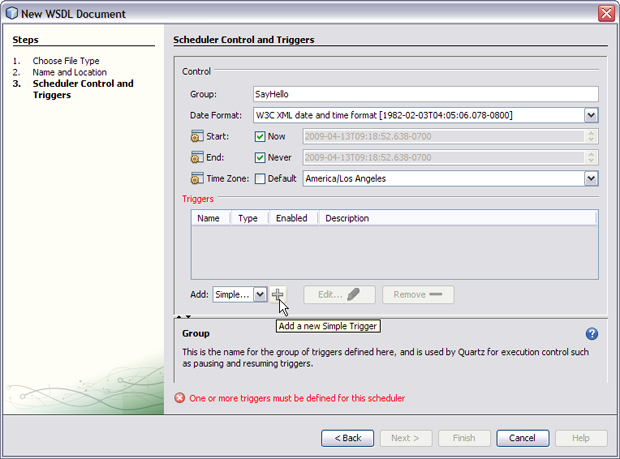
Name: SimpleTrigger1
Description: Say Hello first 20 seconds
Repeat: 4
Interval: 5
Message: Hello first 20 seconds

This creates a trigger that sends the message “Hello first 20 seconds” and repeats it four times in five second intervals for a total of five messages.
SimpleTrigger1 is added to the Triggers field.
The Add New Cron Trigger dialog box appears.
Name: CronTrigger1
Description: Say Hello at the bottom of each minute
From the Second (1) tab, select Just on Second: and select 30 as the value. Leave remaining tabs at their default values.
Message: Hello at the bottom of each minute

This creates a trigger that sends the message “Hello at the bottom of each minute” every minute at second 30, indefinitely.
CronTrigger1 is added to the Triggers field.
The Add New Hybrid Trigger dialog box appears.
Name: HybridTrigger1
Description: Say Hello for the last 20 seconds of each minute
From the Second (1) tab, select Just on Second: and select 40 as the value. Leave remaining tabs at their default values.
Duration: 20 Seconds
Repeat: Indefinite
Interval: 5
Message: Hello for the last 20 seconds of each minute
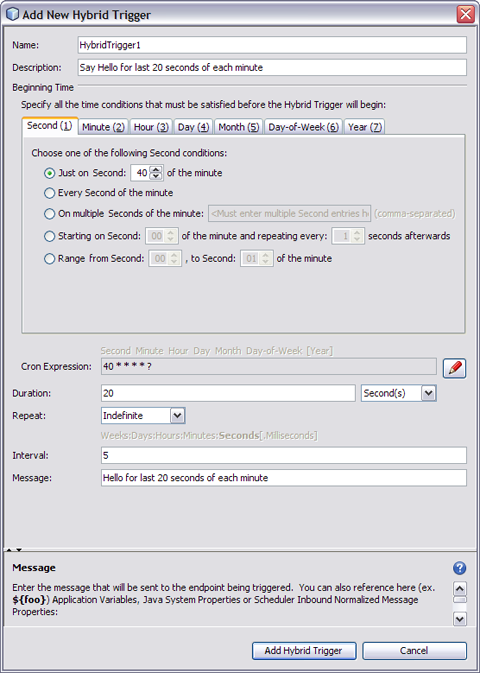
This creates a trigger that sends the message “Hello for the last 20 seconds of each minute” every five seconds, from second 40 through 59 of each minute, indefinitely.
HybridTrigger1 is added to the Triggers field.
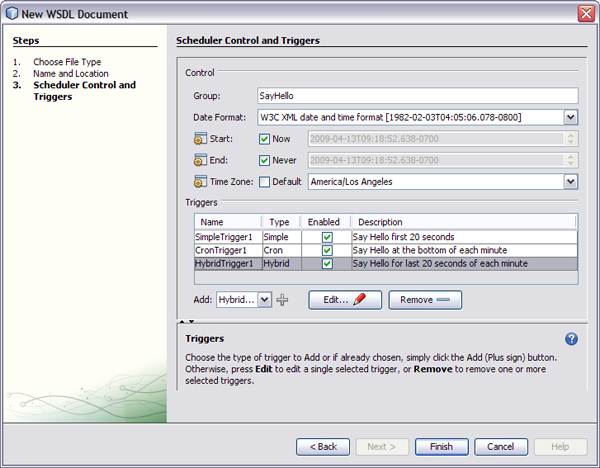
The HelloTriggers WSDL document is added to the SayHello Project's process files.
The WSDL Document Wizard appears.
Name: FileBC
WSDL Type: Concrete
Binding: FILE
Type: Write
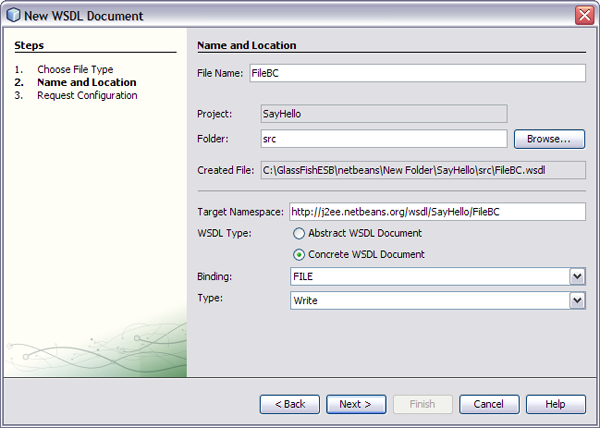
File Exists: Append to Existing File
Payload Processing: Text

The new WSDL file is added to the SayHello Project's process files.
The BPEL Designer opens to the new file.
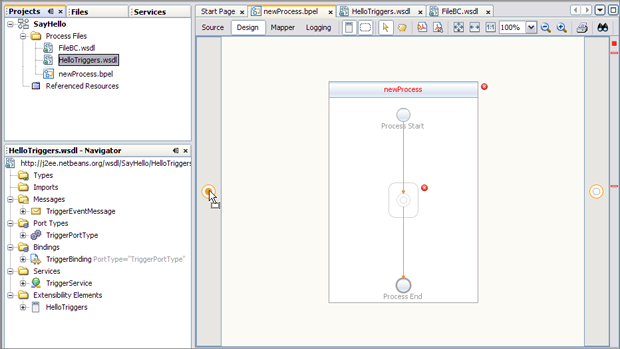
A Partner Link is created.
Another Partner Link is created.
The Receive1 Property Editor appears.
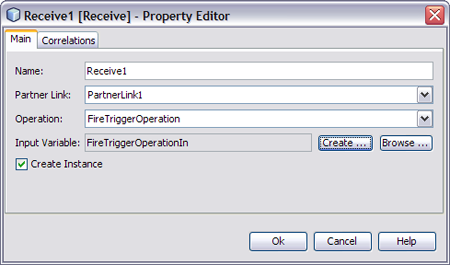
The Invoke1 Property Editor appears.

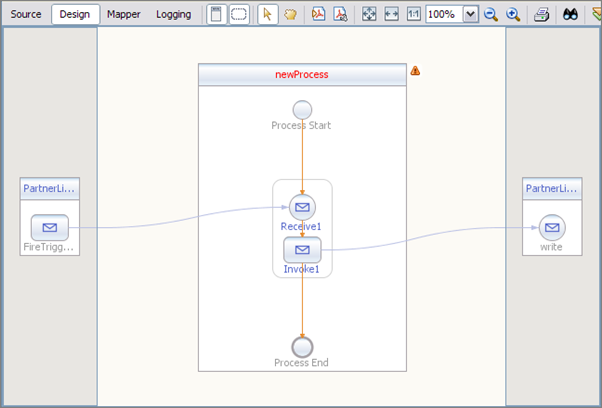
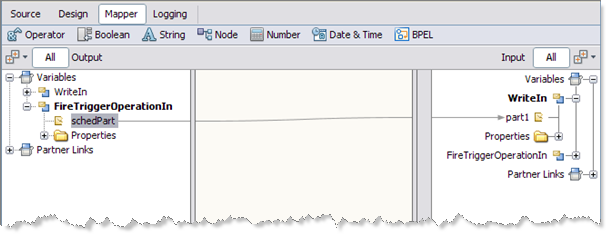
The New Project Wizard appears.
The SayHelloCA Composite Application is added to the Projects tree, and the Composite Application Service Assembly (CASA) Editor opens to the SayHelloCA.casa file.
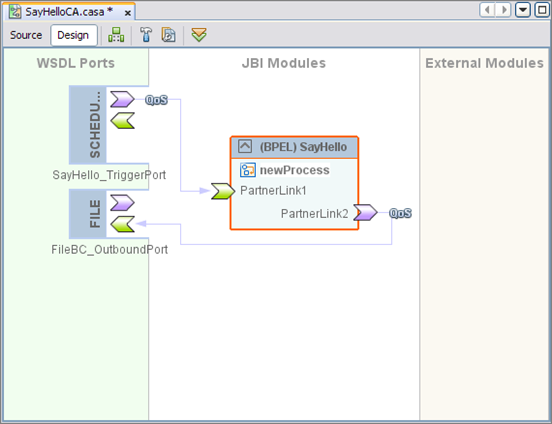
The NetBeans IDE Output window message reports Build Successful when complete.
Again, the NetBeans IDE Output window message reports Build Successful when complete.

As you can see from the output, the Simple trigger fired for 20 seconds only, producing the first messages, the Cron trigger fires once at the bottom of each minute, and the Hybrid trigger fires the last 20 seconds of each minute.